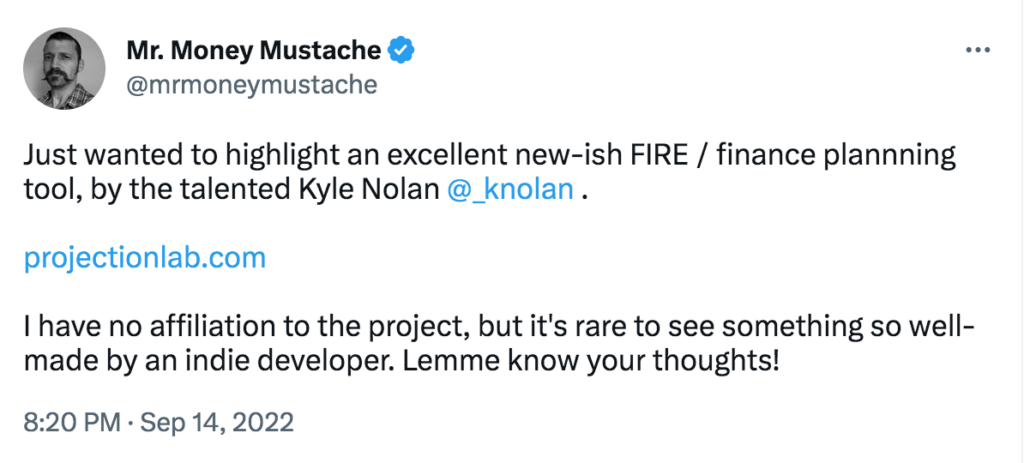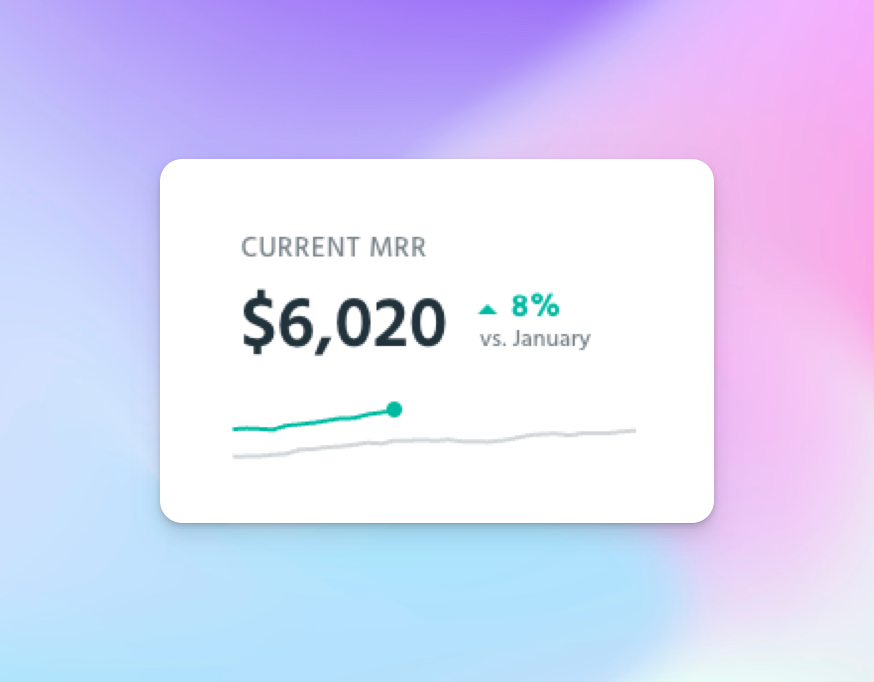AFFILIATE MARKETING
How This 30-Year-Old Grew His Financial Planning Tool to $6k/Month WITHOUT Marketing or SEO

Kyle Nolan got the entrepreneurial bug early on in life. That spirit, together with the discovery of the Financial Independence movement and unsatisfactory search for a financial planning tool, led him to start his current side hustle, ProjectionLab.
For about 2 years, he has been working nights and weekends to develop this financial planning tool all by himself. Currently, he’s bringing in $6k per month and building a small but loyal community of dedicated users. And the adventure has only just begun.
Keep reading to find out:
- What happened when he discovered the FI movement
- How ProjectionLab works
- How he grew it without marketing it
- How growth in sales has evolved over time
- How much time he spends on his business
- His thoughts on SEO
- Which resources and tools he recommends
- His biggest challenge
- His greatest accomplishment
- His main mistake
- His advice for other entrepreneurs
Meet Kyle Nolan
Hey, I’m Kyle. I’m a software engineer from Boston who likes scuba diving, fishing, reading, and hiking… well, last I checked, at least. For the past two years, I’ve spent most of my free time bootstrapping ProjectionLab to $6k MRR as a side project and solo developer.
I just turned 30 this year, and ever since I was a kid, I’ve been passionate about making things. In elementary school, I remember learning excel to create a (terrible) trading card game and sell packs to other kids in the neighborhood. In middle school, I started coding video games, and since then I’ve always had a personal project or two on the side.
Nothing matches that feeling of taking something that’s just an idea in your head and manifesting it in the real world. It will always feel a little like magic. And with side projects, it’s refreshing and liberating to have full creative control, no stand-up meetings, no sprint retrospectives, no changing requirements, and no funding to worry about
ProjectionLab started as one of these creative outlets. I didn’t even have monetization in mind at the beginning.
Over the past 20 years, I’ve accumulated a pretty colossal graveyard of video games and personal projects. However, as people signed up for PL and feedback poured in, it became clear that this was destined for a different fate!
Having a growing and supportive community of users is really energizing, and even though my work is still scoped to nights and weekends while it’s a side project, I’m more than happy to devote those hours because it really doesn’t feel like work.
Why He Created ProjectionLab
Before I discovered the financial independence movement, I often grappled with the feeling that there should be more to life than working until you’re too old to enjoy it.
Does sacrificing the best hours of the best days of your best years to meetings, briefings, and bureaucracy really add up to your best life?
I’ve witnessed how lifestyle inflation, bad planning, and unforeseen events can keep people trapped in that pattern forever. So when I discovered the books and blogs of FI community legends like J.L Collins, Pete Adeney, Morgan Housel, and Grant Sabatier, I realized that I needed to start actually taking control of my financial future. I wanted to know that someday I could have the freedom to be my best self all the time, not just when I’d saved up enough PTO for a vacation.
Theory is nice, but I wanted a hands-on and visual way to map out all the options and explore the trade-offs between different life plans. So, I went looking for a good long-term planning and forecasting tool. Something modern, fluid, nuanced, and actually fun to use.
But somehow, that search for the perfect financial planning tool spiraled out of control… before I knew it, I was building a new one instead.
And after a couple of thousand hours of coding over the past two years of nights and weekends, I created ProjectionLab.
You can create beautiful financial plans with a level of nuance and flexibility that exceeds the standard online retirement calculators, run Monte Carlo simulations, backtest on historical data, review detailed analytics for estimated taxes, plan how to live life on your terms, and with any luck, reduce anxiety around your finances.
There’s a free sandbox if you want to see how it works quickly, it does not ask to link your financial accounts, you don’t have to create an account to try it, it works pretty well for international scenarios, and it respects your data.
As a solo dev building a fairly complex software solution as a side project, I’ve had a product-first approach by necessity, and it took several months just to create the MVP.
There were a grand total of 0 paid users when I posted it to Hacker News on a whim. I closed the tab, expecting that to go nowhere, and then came back an hour later to discover my email inbox was blowing up. I was astonished that the post had made the front page and more than a dozen people had signed up for premium.
Everyone always talks about how incredible it feels to make your first dollar on the internet… and in my experience, they’re right!
The fact that the MVP was actually a hit with the famously critical HN community lit a fire under me, and I doubled down on building out the app and adding everything people wanted to see.
Sometime in the following weeks, it reached 100 paid users, and organic/ word-of-mouth spread, coupled with the occasional post to places like r/SideProject, gradually propelled it into the low hundreds.
Since then, my pattern has been: to spend basically all my time with my head in the sand developing cool new features, occasionally picking it up to create a post somewhere like Reddit or HN, and also nurturing a community of users who love the tool.
I know the “spend all my time on development” part contradicts much of the conventional SaaS business advice. Still, this may be one of those rare cases where a laser focus on the product before marketing has been a good thing overall.
By scaling up the user base gradually, I’ve been able to avoid drowning in support requests and preserve the free time I’ve needed to re-architect and redesign the product several times before arriving at the more polished solution it is today.
Over the past few months, I was lucky enough to have some unexpected developments help to spread the word even more and close the remaining distance from ~750 paid users to the 1k mark:By scaling up the user base gradually, I’ve been able to avoid drowning in support requests and preserve the free time I’ve needed to re-architect and redesign the product several times before arriving at the more polished solution it is today.
– Pete Adeney (a.k.a. Mr. Money Mustache) gave PL a shout-out on Twitter

– Rob Berger (the author of Retire Before Mom and Dad) created a video review.
– Cody Berman and Justin Taylor, who run The FI Show, asked me to come on their podcast.
How Much Money Kyle is Making
ProjectionLab just crossed $6k MRR.

It took about 22 months to reach $6K MRR
→ 9 months to get to $1,000
→ 4 months to get to $2,000
→ 7 months to get to $5,000
→ 2 months to get to $6,000
Here’s a look at how the paid user base has grown over time:

How Many Hours a Week Kyle Spends on his Business
For now, I am building ProjectionLab as a side project. The breakdown for an average week looks something like:
Weeknights: 8pm to midnight
Weekends: ~10 hrs per day
So, around 40 hrs per week in total, on top of a full-time job.
I guess now is the part where you go “Oh, okay, so this guy just has no life.”
Well, side projects certainly have their pros and cons. The best part is the risk reduction. If you were to leap to full-time right away instead, I bet that liberating feeling of having complete creative control gets overpowered pretty quickly when it hits you that “this better work.”
But the worst thing about side projects is that they force you to sacrifice more of your most precious non-renewable resource: time.
The hard truth is that burning the candle at both ends means you rarely have time for everything you want to do in life. Something has to give. For me, that was playing video games.
I still carve out the time to exercise daily and try to do at least one fun social thing per week, but I also used to have a group that would play games regularly. That was my favorite way to stay in touch over long distances.
But the math just didn’t work while trying to bootstrap a complex technical project on the side. Some day in the future though, maybe I will come out of video game retirement and rejoin the squad.
Kyle’s Top Marketing Strategy
After validating the idea with PL version 1.0, the main thrust of my efforts has simply been to make the product so dang good that, eventually, people in this space can’t help but take notice. Maybe that’s finally working a little bit.
His View on SEO
I’ve barely thought about SEO and have no discernable content strategy. So yeah… you could say there’s plenty of room for improvement on the marketing side.
The primary focus has been to invest my extremely limited time in a way that (hopefully) manufactures some luck and exposure as a byproduct of creating a standout software solution.
But even though PL has been steadily growing over the past couple of years, I always remind myself that a mediocre product with great marketing often beats a great product with poor marketing. So at some point, I need to think more seriously about creating a reliable and sustainable long-term growth engine.
His Email List
I have an email list with a couple of thousand members, but one of my mistakes was implementing the “subscribe to newsletter” option late in the game. That should have been a part of the app since day one, not added a year late!
Kyle’s Favorite Resources
For those who have an interest in financial independence, here are a few of my favorites:
- The Simple Path to Wealth, by J.L. Collins
- The Psychology of Money, by Morgan Housel
- A Random Walk Down Wall Street, by Burton Malkiel
- Retire Before Mom and Dad, by Rob Berger
- Financial Freedom, by Grant Sabatier
Or, if you’re an indie developer looking to create your own app, here’s a tech stack that has served me well: Vue.js, Vuetify, Chart.js, Paddle, Firebase, and GCP.
His Top 3 Tools
Using a modern, component-based web development framework with a good material UI library (in my case Vue.js and Vuetify) has enabled me to rapidly build engaging and responsive interfaces that users actually enjoy spending time in.
I chose Paddle for my subscriptions and billing platform, and so far, that’s been smooth sailing.
Initially, Stripe lured me in with their excellent UX and developer APIs. But as a solo dev with serious time constraints, I wanted a full merchant of record solution that would handle all the complexities of collecting and remitting sales tax, VAT, etc. So at the end of the day, Paddle was the easy choice.
I also used Changemap to create a free public roadmap where anyone can suggest new features and vote. I set up a Discord server which has steadily been growing into a thriving community where people can ask questions, give feedback on the latest features in early access, and chat about personal finance and other topics with folks who share similar interests.
His Biggest Challenge
Given limited time, how to decide what to build and what not to build.
I always have a notional roadmap in my head, and it’s always being revised and rearranged based on:
- What is the community asking for right now? What topics keep coming up again and again in Discord/email?
- What are the most upvoted features on the public roadmap?
- What did I originally think I would be doing next?
- What do I actually **feel** like doing next? What would I be most energized and inspired to work on?
As I toss all the ideas around, I’ll usually try to add weights to them based on:
- Estimated level of effort/time required
- Chance to delight existing users and keep them around
- The prospect of spurring new growth
- Opportunity to reduce technical debt
- Feature “coolness factor”
- Chance to further differentiate from other products
- Opportunity to build new skills and knowledge
His Greatest Accomplishment
The simple ability to stick with projects long enough to finish them, release them into the world, and give them a chance to grow.
It’s common among developers to start lots of projects, but ship very few. It’s easy to get halfway done, run into some edge cases, and then just move on to the next shiny idea or technology.
But you won’t hit any of the larger entrepreneurial milestones if you can’t commit to a vision long enough to get something out the door.
What He Wishes He Knew When He Started
I wish I had known about the importance, and compounding effect, of building an audience.
You can have the best product in the world, but it won’t go anywhere if you can’t get enough eyeballs on it.
You want to start building a following and a user community as soon as possible.
Kyle’s Biggest Mistake
For a few months during the middle of my journey with PL, I was working on a major overhaul and putting in an unsustainable number of hours. Time is a zero-sum game, and I was letting sleep and exercise take the hit… and my vitals started to reflect that.
Beyond all the tips and tricks, you need to take care of yourself first and foremost.
Launching and growing a small startup requires consistency and persistence. And luck. And a bunch of other things.
But the point is: it’s a marathon. So only burn the candle at both ends when there’s a tactical reason. And always make time to exercise! What’s the point of working towards a better future if you might not be around to enjoy it?
His Advice for Other Entrepreneurs
If you’re just starting your own journey or contemplating a new project, here’s a small piece of advice from my experience so far:
Try to find a problem you understand deeply and truly care about solving, and build something that you’ll actually be a user of.
There are often more hurdles on the path to finishing and launching a project than you can predict going in; but if you really have that desire to see and enjoy the final product yourself, you can use that to help power through some of the obstacles.
It’s a lot easier to pursue an idea with persistence when you’re working on something you love and that you personally can’t wait to use.

![How AEO Will Impact Your Business's Google Visibility in 2026 Why Your Small Business’s Google Visibility in 2026 Depends on AEO [Webinar]](https://articles.entireweb.com/wp-content/uploads/2026/01/How-AEO-Will-Impact-Your-Businesss-Google-Visibility-in-2026-400x240.png)
![How AEO Will Impact Your Business's Google Visibility in 2026 Why Your Small Business’s Google Visibility in 2026 Depends on AEO [Webinar]](https://articles.entireweb.com/wp-content/uploads/2026/01/How-AEO-Will-Impact-Your-Businesss-Google-Visibility-in-2026-80x80.png)














